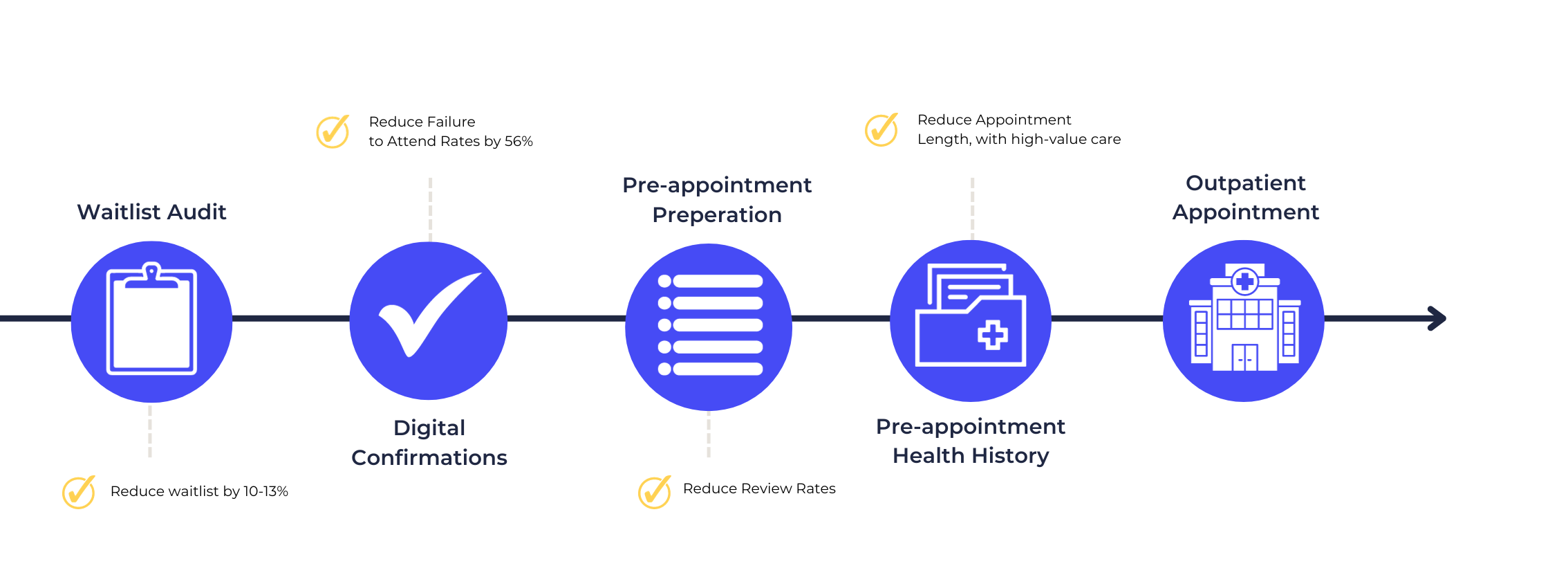Outpatient Appointments
Replacing one-way letters and text messages with a secure two-way channel for patients to confirm their attendance and screen their readiness for care.
Effortlessly shift from time-consuming manual processes that rely on outdated contact details and result in missed appointment times to a streamlined digital pathway.
In just 4 weeks, increase patient flow through your outpatient clinics, alleviate administrative workload, and elevate patient care accessibility.
Results presented at ACHSM Health Leaders Congress 2023
Reduce Failure to Attend Rates
56%
Reduce Manual Phone Calls by staff
91%
Live within
4 Weeks
Outpatient Waitlist Optimisation
Improve patient experience, reduce no-shows for outpatient appointments and improve patient flow

Reduce the time taken to audit your waitlist
In four weeks, convert your outpatient audit workflow from traditional letters, phone calls, and texts into an efficient digital patient journey.
The manual and labour-intensive process of auditing patient wait lists with letters, calls, and texts that often go unanswered consumes scarce time from frontline staff and limits visibility to the true size of your waitlist.
This means:
-
Delays in patients getting access to care
-
Limited visibility to an accurate reflection of the waitlist
-
Consumes scarce clinical staff time making repeated, unanswered phone calls.
Reduce outpatient failure to attend rates with a customisable digital pathway.
Cut down failure to attend rates for outpatient appointments
Failure to attend (FTA) rates in outpatient departments of public hospitals represent a critical challenge.
When patients miss a scheduled appointment, appointment slots go unutilised with patients on the waitlist who could have accessed their care.
This exacerbates wait times for patients, impacting the ability of a health service to deliver access to care objectives. This also disrupts patient flow and places additional administrative burdens on frontline staff.
Allowing patients to confirm their attendance to an appointment in advance via a digital pathway allows staff to manage, by exception, the cases where appointments can be reallocated to waiting patients. Digital pathways also ensure patients are better informed and prepared for their appointments. Central Adelaide Health Network’s outpatient clinic reduced appointment failure rates by 56%.

Reduce review and rebooking rates
Digital outpatient pathways can also support standardised screening of patients’ readiness for care by appointment to ensure patients arrive appropriately prepared for their appointments. Outpatient clinics can ask patients to confirm if they have completed all tests, scans or any other medical imaging before their appointment date, ensuring they arrive prepared and reducing rebooking rates.
Digital pathways are also being used by Australian health services to capture and screen patient histories in advance of outpatient clinics, so clinicians have access to this information before upcoming outpatient appointments – so that their time with patients can be focused on high-value care.
This creates visibility and allows the outpatient clinic to be proactive, further optimising the throughput of patients through outpatient clinics and improving patient access.
Improve patient access by reducing your outpatient waiting list
We’re supporting health services to reduce long wait times for outpatient appointments by improving visibility so that appointment slots are filled and patients arrive prepared.
Improve timely access to care whilst reducing the administrative burden on frontline staff to coordinate the flow of patients through outpatient clinics.
Digital outpatient pathways offer an efficient and cost-effective solution to navigating outpatient appointments and waiting list.
Outpatient clinics can be live in 4 weeks, reduce the FTE being consumed on low-value tasks significantly, and redirect resources to high-value care.

Launch your digital outpatient pathways in 4 weeks
What outpatient services are using Personify Care's digital pathways?
Public hospital outpatient services across Victoria, Queensland and South Australia are using Personify Care’s digital patient pathways to audit waitlists plus support patients throughout their journey, from confirming and rescheduling appointments to continuing to support patients once on the elective surgery waitlist.
How do Personify Care's digital pathways confirm if a patient still requires their outpatient appointment?
Patients are sent a text message prompting them to access a secure portal to confirm their identity and if they still require an outpatient appointment.
Can the waitlist audit pathway be customised to our outpatient services protocols?
The outpatient waitlist audit and outpatient appointment pathways can be fully customised to your local health services patient journey.
Why Outpatient Clinics use digital waitlists pathways alongside existing hospital system?
Outpatient clinics across public hospitals are using digital patient pathways to optimise service capacity and manage demand for scarce resources. Our digital patient pathways are a rapid, scalable solution that can work alongside your local hospital’s referrals, appointments, and hospital visits. Existing models of sending an outpatient appointment letter and making repeated phone calls to confirm outpatient appointments are impacting clinic capacity and leading to longer waiting times.
Can the digital pathway continue beyond the waitlist audit?
Yes, Personify Care’s digital patient pathways can be for more than just confirmations and education prior to your appointment and can be used throughout the patient journey – from referral to confirming medical specialist appointments, prehabilitation prior to elective surgery, pre-admission smart screening, and education to post-discharge support. Pathways can be personalised to each patient or specialist doctor requirements for medical condition or medical treatment.
Health Grade Security & Privacy.
Powered by Personify Care platform that’s been used to monitor over 10.1 million patient interactions and screen over 9.3 million clinical risks.
Interoperability by design. Information collected from patients can be stored as part of their patient record via integration into your Patient Management System (PMS) or Electronic Medical Record (EMR).
Meets all Australian & New Zealand privacy & security requirements.
HIPAA Compliant for US providers.
Patient identity verified through 2-factor authentication.
Patient opt-in consent at registration to share information with healthcare team.
All information stored onshore.
Adheres to strict security standards with all data encrypted in transit and at rest.
Trusted by world-class healthcare providers





